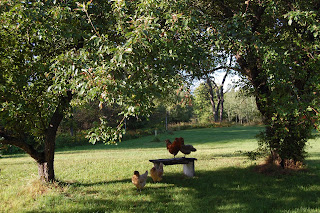
There is nothing like sitting at your dining room table in the dead of winter and looking down a plate of food that was all harvested on your property. It's a rewarding feeling that brings warmth to you heart knowing how healthful you are treating your body. The green beans, broccoli and cauliflower from the freezer, the garlic, onions, carrots, winter squash and potatoes from the root cellar, the pantry full of canned vegetables and jams, and the meat that was raised or hunted here on the property all make cooking a delicious meal pretty easy. I know where my food came from and I know how it was produced. It takes a lot of time and effort to do what we do, but it is well worth it.

I am pretty new to this 'putting up your food' concept and have relied heavily on websites and books to guide me along in this process. My sister gave me a book titled
"The Complete Book of Small-Batch Preserving: Over 300 Recipes to Use Year-Round" by Ellie Topp and Margaret Howard. This book has been extremely helpful in finding excellent recipes for pickles, chutneys, salsas and jams. The batches I preserve are by no means "small", so I do have to double and sometimes triple the recipes. The website www.pickyourown.org has be tremendously helpful when learning about blanching and freezing produce and canning beans and tomatoes. I've used several recipes from this site and highly recommend it for anyone looking to preserve food.
 Once August rolls around, everyone is sick of zucchini! They are prolific and can get away from you if you are not out there picking daily. The ones that are as large as baseball bats are not really good for grilling or sauteing, but are perfect for shredding for zucchini bread (see recipe in a previous post) or for a delicious zucchini relish. This relish is great on brats or hot dogs. A friend told me she made a pasta and chicken salad out of the relish and it turned out great. So, here is the recipe! Enjoy!
Once August rolls around, everyone is sick of zucchini! They are prolific and can get away from you if you are not out there picking daily. The ones that are as large as baseball bats are not really good for grilling or sauteing, but are perfect for shredding for zucchini bread (see recipe in a previous post) or for a delicious zucchini relish. This relish is great on brats or hot dogs. A friend told me she made a pasta and chicken salad out of the relish and it turned out great. So, here is the recipe! Enjoy!
 Zucchini Relish
Zucchini Relish
7 cups shredded zucchini
3 cups shredded yellow squash
2 cups chopped onions
5 Tbsp. canning salt
6 bell peppers, chopped (red, yellow, orange or green)
1 small hot pepper, chopped
2 1/2 cups apple cider vinegar
2 1/2 cups white sugar
2 1/2 cups brown sugar
2 Tbsp. celery seed
1 Tbsp. nutmeg
1 Tbsp. tumeric
1/2 tsp. black pepper
2 Tbsp. cornstarch
Place squash, onions and salt in a pan overnight. Rinse well and strain the excess water. Add remaining ingredients to the pan and cook for 30 minutes. Place in hot sterilized canning jars and process in a hot water bath for 15 minutes after the water boils. If the jars did not seal, store the relish in the refrigerator.



 These Aurora photos were taken last fall. We were coming home from a fall color tour and saw peaks of light appearing in the sky. They intensified throughout the night and were a joy to witness. This was the first time we have seen them this vibrant over the property. They were too beautiful not to share, a little late but we feel it's worth it.
These Aurora photos were taken last fall. We were coming home from a fall color tour and saw peaks of light appearing in the sky. They intensified throughout the night and were a joy to witness. This was the first time we have seen them this vibrant over the property. They were too beautiful not to share, a little late but we feel it's worth it. 


































